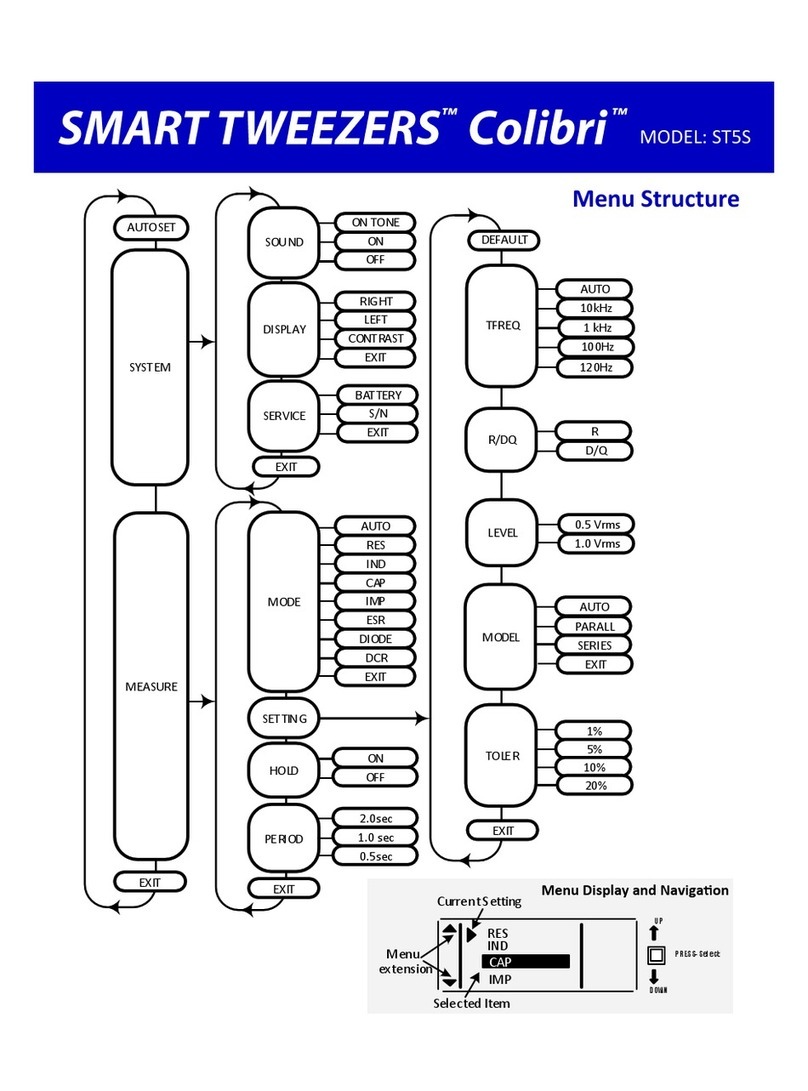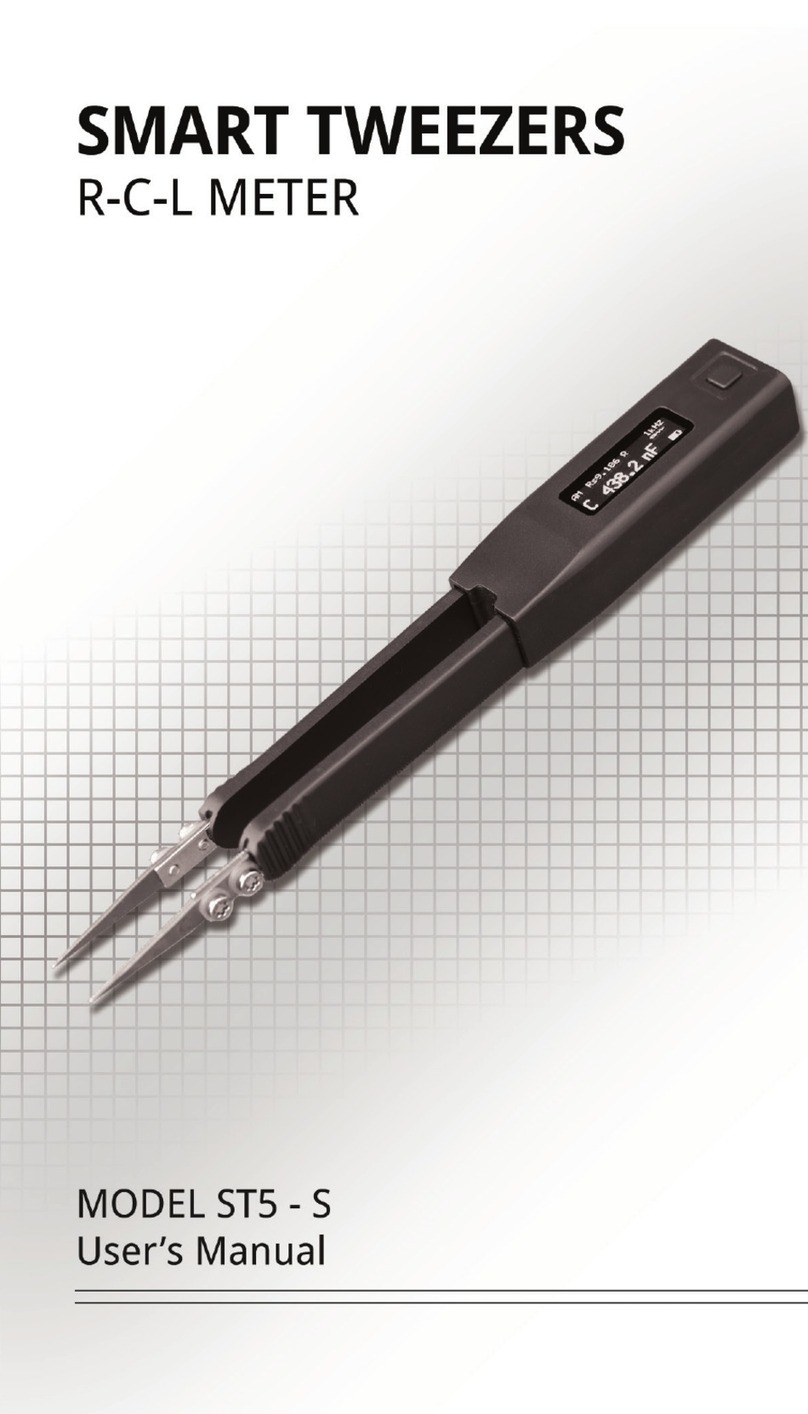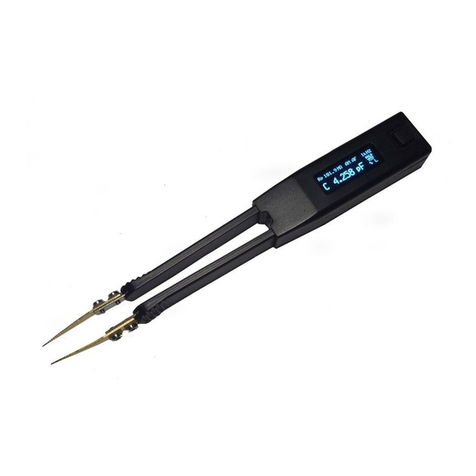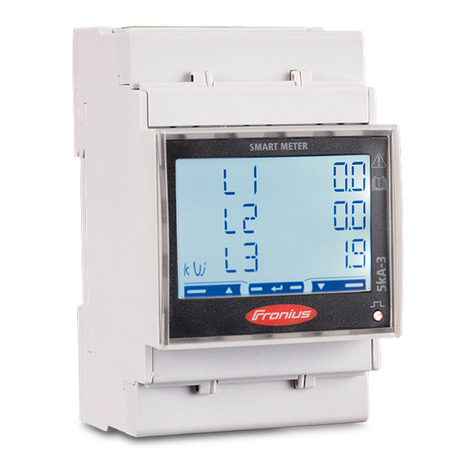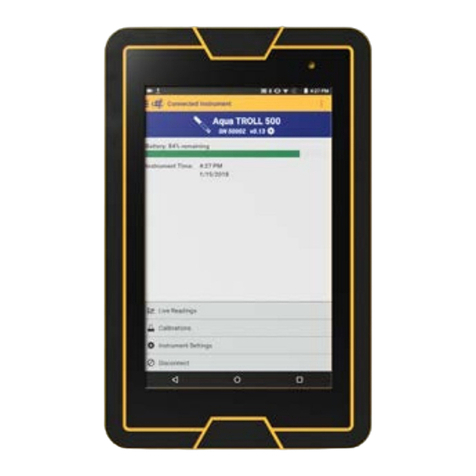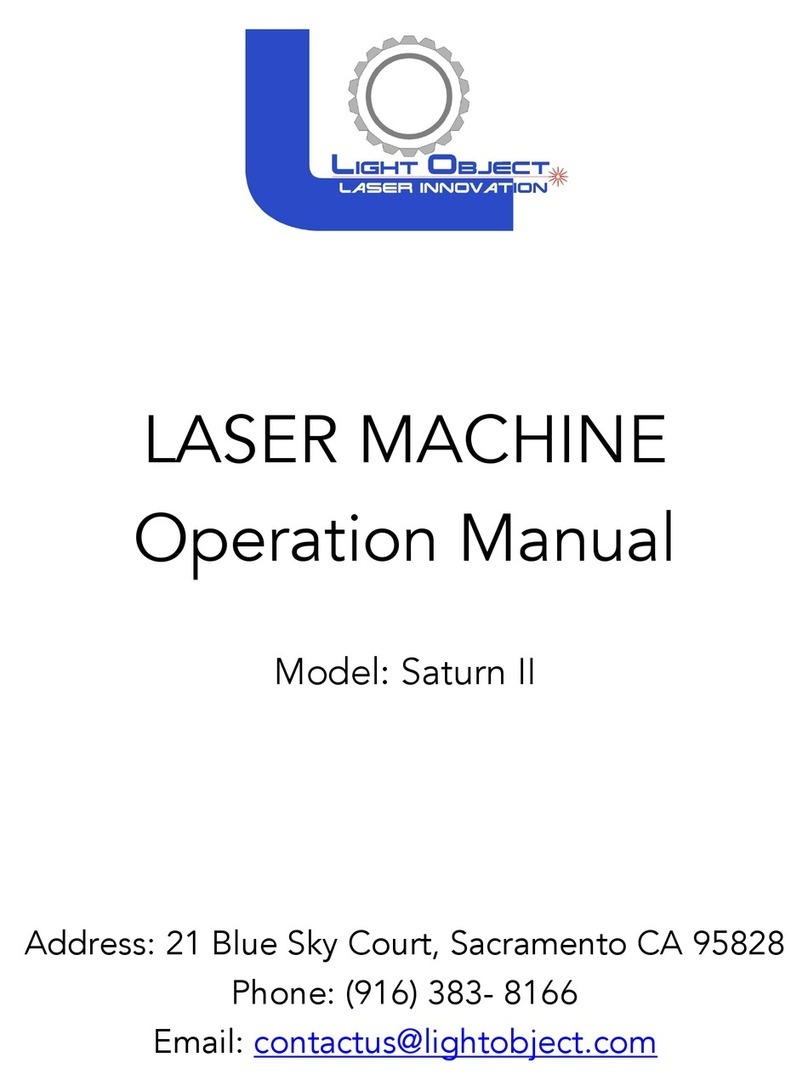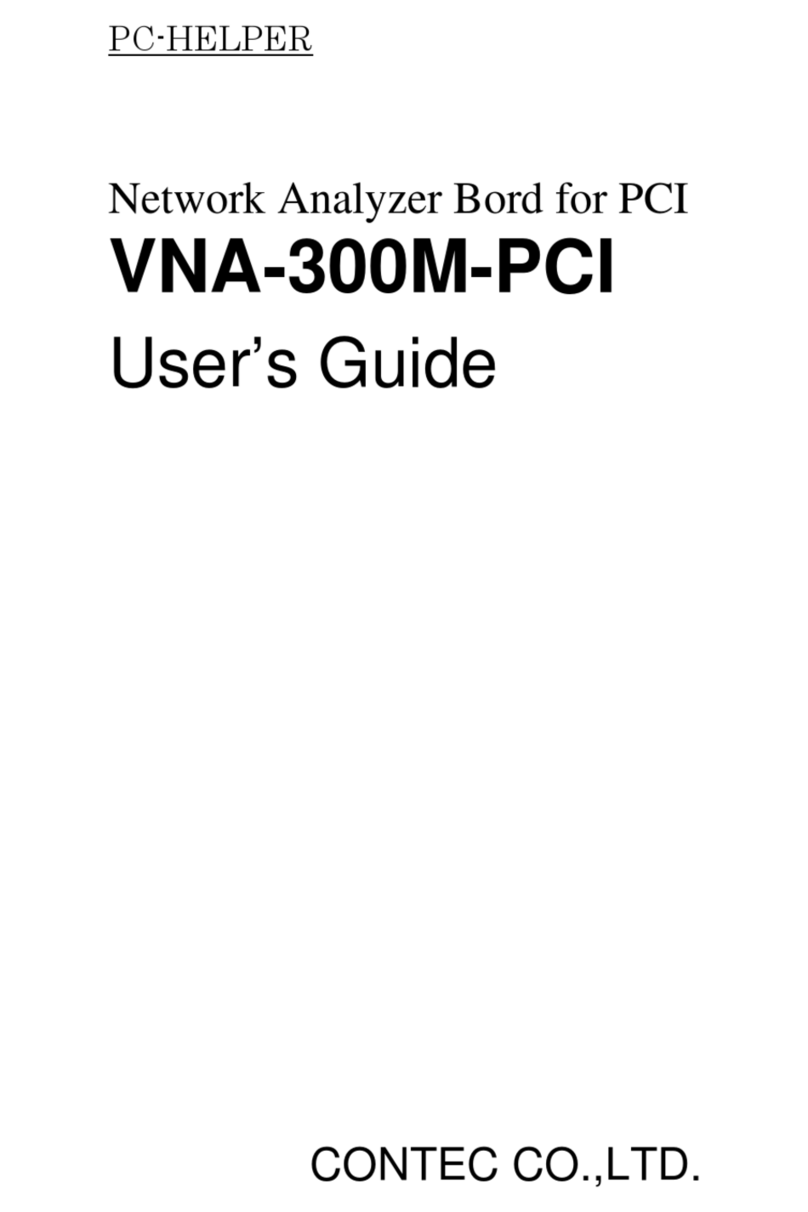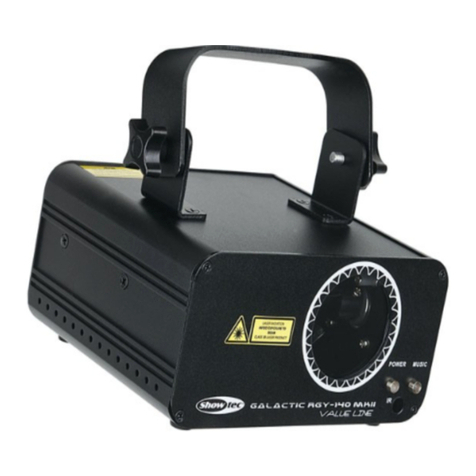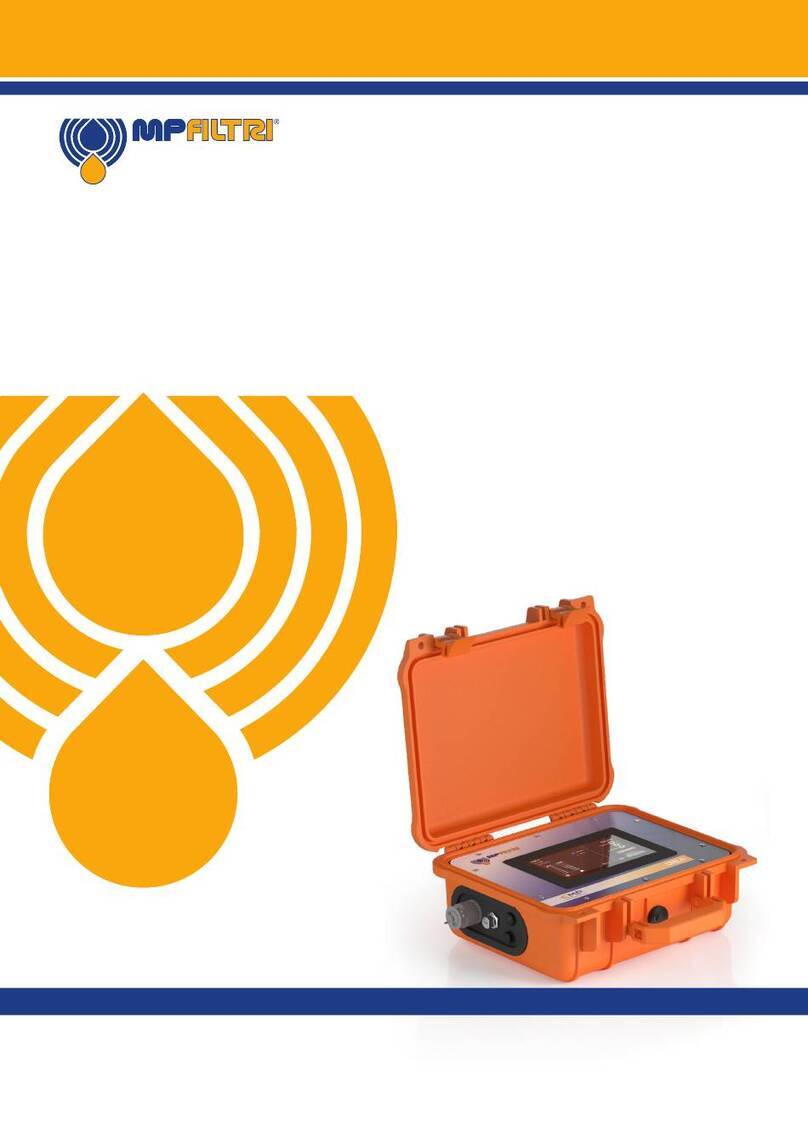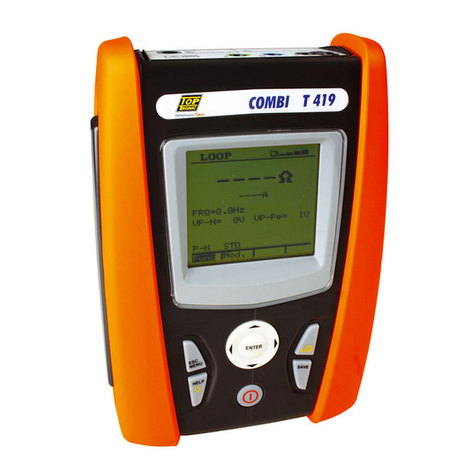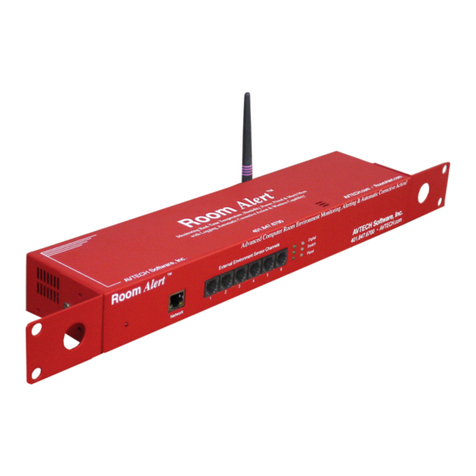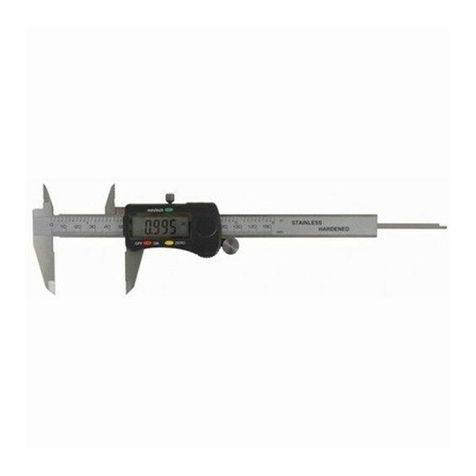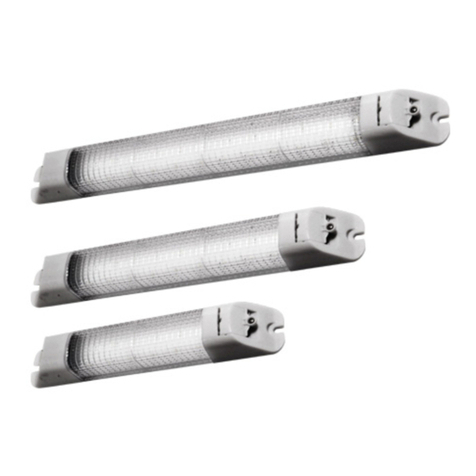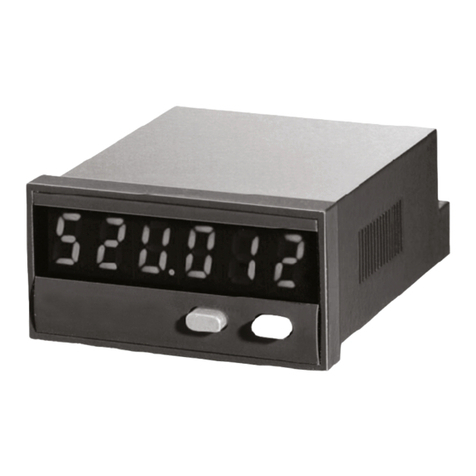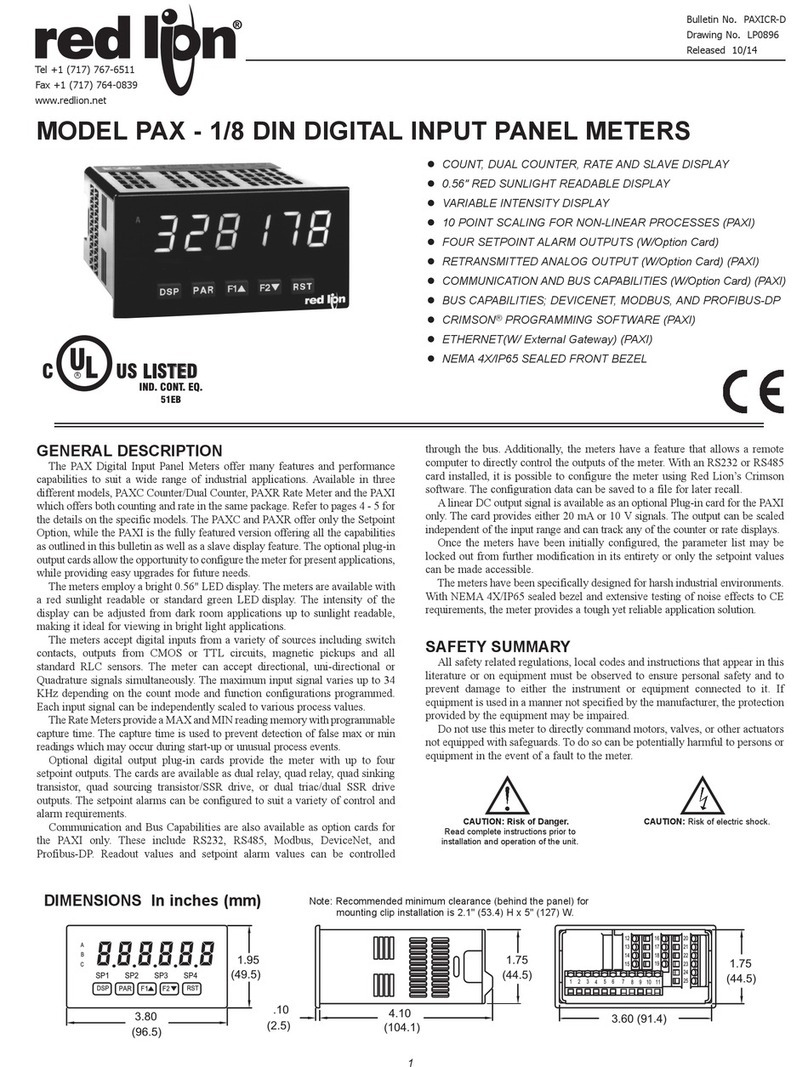Smart Tweezers ST5SBT User manual

2 3

TABLE OF CONTENTS
Notice 1
Warranty 1
Safety Precautions 2
Getting Started 3
Overview 3
How it works 4
Controls 5
Power On 6
Display 6
Displayed Parameters 7
Menu Structures And Functions 8
Measurement menu 12
Setting Menu 14
Measurement Features 19
Maintenance 21
Labelling&VericationRequirements 22
AppendixA.Specications 23
Appendix B. Default Settings 25
AppendixC.AccuracySpecication 25

1 2
NOT ICE: TO THE BEST OF OUR KNOWLEDGE THIS DOCUMENT IS BELIEVED TO BE ACCUR ATE. THE MANUFAC TURER RESERVE STHE RIGHT TO
CHANGE THEINFORMATION AND DOES NOT ASSUMEANYRESPONSIBILITYFOROMISSIONS AND/OR ERRORS FOUND IN THIS DOCUMENT.
WARRANTY: MANUFACTURER WARRANTS THIS PRODUCT TO BE FREE FROM DEFECTS IN MATERIALS AND WORKMANSHIP
FOR A PERIOD OF ONE (1) YEAR FROM THE SHIPMENT DATE. MANUFACTURER WARRANTS THE FOLLOWING ITEMS FOR
NINETY (90) DAYS FROM THE DATE OF SHIPMENT: RECHARGEABLE BATTERIES, DISKS AND DOCUMENTATION. DURING THE
WARRANTY PERIOD, THE MANUFACTURER WILL, AT ITS DISCRETION, EITHER REPAIR OR REPLACE ANY PRODUCT THATPROVES
TO BE DEFECTIVE. TO EXERCISE THIS WARRANTY, WRITE OR CALL YOUR LOCAL DISTRIBUTOR. YOU WILL BE GIVEN PROMPT
ASSISTANCE AND RE TURN INSTRUC TIONS. PLEASE SEND THE PRODUCT WITH SHIPPING PREPAID TO THE INDICATED SERV ICE
FACILITY. REPAIRS WILL BE MADE AND THE PRODUCT WILL BE RETURNED TO YOU. REPAIRED OR REPLACED PRODUCTS ARE
WARRANTED FOR THE BALANCE OFTHE ORIGINAL WARRANTYPERIOD,OR NINETY (90) DAYSFROMTHE DATE OF THE REPAIR.
THIS WARR ANTY DOES NOT COVER THE REPAIR OF ANY PRODUCT WHOSE SERIAL NUMBER HAS BEEN ALTERED, DEFACED OR
REMOVED. THIS WARRANT YDOES NOT COVER FINISHES (SCR ATCHES ON SURFACE OR SCREEN), NORMAL WEAR AND TE AR, NOR
DOESIT COVER DAMAGE RESULTING FROMMISUSE, DIRT,LIQUIDS,PROXIMITY OR EXPOSURE OFHEAT,ACCIDENT,ABUSE, NEGLECT,
MISAPPLICATION,OPERATIONOUTSIDEOFTHEENVIRONMENTALSPECIFICATIONS,TAMPERING,UNREASONABLE USE,SERVICE
PERFORMED OR ATTEMPTED BY UNAUTHORIZEDSERVICECENTERS, FAILURE TO PROVIDE REASONABLE AND NECESSARY MAINTENANCE.
THIS WARRANTY DOES NOT APPLY TO DEFECTS RESULTING FROM PRODUCT MODIFICATION WITHOUT MANUFACTURER’S
EXPRESS WRITTEN CONSENT, OR MISUSE OF ANY PRODUCT OR PART. THIS WARRANTY ALSO DOES NOT APPLY
TO SOFTWARE, NON-RECHARGEABLE BATTERIES, DAMAGE FROM BATTERY LEAKAGE, AND IMPROPER POLARITY
OF THE BATTERIES OR PROBLEMS ARISING FROM NORMAL WEAR OR FAILURE TO FOLLOW INSTRUCTIONS. THIS
WARRANTY DOES NOT COVER LCD DAMAGE, PHYSICAL DAMAGE TO THE JOG DIAL BUTTON, SLIDE SWITCH AND
RESET SWITCH; ELECTRICAL DAMAGE OF THE PRODUCT DUE TO HIGH VOLTAGE OR IMPROPER BATTERY TYPE.
THE DESIGN AND IMPLEMENTATION OF ANY CIRCUIT BASED ON THISPRODUCTIS THE SOLE RESPONSIBILITY OF THE CUSTOMER.
MANUFACTURER DOES NOT WARR ANT ANY DAMAGE THAT OCCURS AS A RESULT OF THE USER’S CIRCUIT OR ANY DEFECTS THAT
RESULT FROM USER-SUPPLIED PRODUC TS. THIS WARRANT Y DOES NOT APPLY TO REPAIRS OR REPL ACEMENTS NECESSITATED
BY ANY CAUSE BE YOND THE CON TROL OF FACTORY INCLUDING, BUT NOT LIMITED TO, OPER ATION CONTRARY TO FURNISHED
INSTRUCTIONS, SHIPPING ACCIDENTS, MODIFICATIONOR REPAIR BY THEUSER,NEGLECT,ACCIDENTS OROTHER ACTSOF GOD.
THE FOREGO ING IS IN LIEU OF ALL OTHER EXPRESSED WARR ANTIES AND THE MANUFACTURER DOES NOT ASSUME OR AUTHORIZE
ANY PART Y TO ASSUME FOR IT ANY OBLIGATION OR LIABILIT Y. THE DUR ATION OF ANY WARR ANTIES THAT MAY BE IMPLIED BY LAW
(INCLUDING THE WARRANTIES OF MERCHANTABILIT YAND FITNESS) IS LIMITED TO THE TERM OF THIS WARRANT Y. IN NO EVENT
SHALL THE MANUFACTURER BE LIABLE FOR SPECIAL, INCIDENTAL OR CONSEQUENTIAL DAMAG ES ARISING FROM OWNERSHIP OR
USE OF THIS PRODUCT, OR FOR ANY DELAY IN THE PERFORMANCE OF ITS OBLIGATIONS UNDER THIS WARR ANT YDUE TO CAUSES
BEYOND ITS CONTROL. THIS WARRANT Y IS LIMITED IN DURATION TO ONE (1) YEAR FROM THE DATE OF ORIGINAL PURCHASE.
THIS WARRANTY IS IN LIEU OF ALL OTHER WARRANTIES, EXPRESSED OR IMPLIED, INCLUDING ANY IMPLIED WARRANTY OF
MERCHANTABILIT Y OR FIT NESS FOR A PARTICULAR USE. THE REMEDIES PROVIDED HEREIN ARE BUYER’S SOLE AND EXCLUSIVE
REMEDIES.NEITHERMANUFACTURER,NORANYOFITSEMPLOYEESSHALLBELIABLEFORANYDIRECT,INDIRECT,SPECIAL,INCIDENTAL
OR CONSEQUENTIAL DAMAGES ARISING OUT OF THE USE OF ITS DEVICES AND SOFTWARE EVEN IF MANUFACTURER HA SBEEN
ADVISED IN ADVANCE OFTHE POSSIBILITY OFSUCH DAMAGES.SUCH EXCLUDED DAMAGESSHALL INCLUDE,BUT ARE NOT LIMITED TO:
COSTS OF REMOVAL AND INSTALLATION, LOSSES SUSTAINEDAS THERESULTOF INJURYTO ANY PERSON, ORDAMAGETO PROPERTY.
SAFETYPRECAUTIONS
The following safety precautions should be observed prior to using
this product and any associated accessories. Although devices and
accessories would normally be used with non-hazardous voltages,
there are situations where hazardous conditions may be present.
This produc t is intended for use by qualied personnel who
recognize shock hazards and are familiar with the safety precautions
required to avoid possible injury. Read and follow all installation,
operation, and maintenance instructions carefully before g the
product. Refer to the manual for complete product specications.
If the product is used in a manner not specied, the
protection provided by the product may be impaired.
Inspect the Smart Tweezers case before using.
Do not use the device if it appears to be damaged.
• Do not use the device if it operates abnormally.
• Do not attempt to measure any components in-
circuit when your circuit is alive or active.
To avoid possible damage to Smart Tweezers or to the
equipmentundertest,followtheseguidelines:
• Disconnect circuit power supply and discharge all high-voltage
capacitors before testing resistance, inductance, or capacitance.
• Do not apply external voltages of more than 1.6 V.
• Use proper terminals and functions for your measurements.
• Only supplied charger (DC 5V) should be used to charge the battery.
SAFETYSYMBOLSANDTERMS
The WARNING heading in this manual indicates
dangers that might result in personal injury or death.
Always read the associated information very carefully
before performing the indicated procedure.
The CAUTION heading in the manual indicates hazards that could
damage the device. Such damage may invalidate the warranty.

3 4
GETTINGSTARTED
This section summarizes basic operation of Smart Tweezers.
In the section:
OVERVIEW:Overview of the device controls.
POWER-ON:Describes the power-on and power-off sequence,
the warm-up time, and default conditions.
DISPLAY:Discusses the display format and messages that
may appear while using the device.
MENUSTRUCTURE:Covers menu structure, system
settings and features.
OVERVIEW
Smart Tweezers (ST) is a portable impedance measuring
device. ST is capable of measuring resistance, capacitance
or inductance over a range of more than 8 orders of
magnitude. The device has a basic accuracy better than
0.2% (resistance) and operates at four test frequencies.
Smart Tweezers is controlled by a microcontroller that sets
measurement conditions, processes data and operates the display
and user interface. The device has a unique mechanical design that
allows manipulation SMT components with size down to 0201.
In actual use Smart Tweezers provides more accurate results than
most of the benchtop LCR meters due to small and very predictable
parasitics of its probes. Probability of measurement errors
associated with setup (wires, tips, probes and etc.) is minimal.
HOWITWORKS
ST evaluates impedance of a component by measuring the voltage
across the component and current through it. The complex ratio
of voltage to current is equal to the complex impedance. The unit’s
processor calculates various parameters that are displayed i.e. R, C or L.
Voltage across the component is generated by the test signal
source Vs. Both the amplitude and frequency of Vs can be set. The
voltage is applied to the device under test (DUT) through the source
resistance Rs. Current ows to the virtual ground of the current
amplier AI, and through the current conversion resistor Ri. The
output of AI provides a signal proportional to the current, I*Ri.
Voltage across the DUT is measured by a separate signal path
(amplier AU), thus providing a pseudo 4-wire Kelvin connection.
Voltage and current signals are processed by the A/D converter.
Obtained values are then corrected using calibration factors,
converted to impedance and sent to the display.
There are four selectable frequencies: 100Hz, 120Hz,
1.0kHz and 10kHz. The output frequency is accurate
to 50 ppm (0.005%). Frequencies are set in the menu
or by moving the Navigation Control UP.
There are two output voltage levels that can be selected: 0.5 Vrms
and 1.0 Vrms. The accuracy of the output voltage levels is 2 %.
The output voltage is applied to the device under test through the
source impedance. The voltage across the device is always less than
or equal to the output voltage. The source impedance value is 100Ω .
DUT AU
RS
VS
VOLTAGE SIGNAL
TO ADC
CURRENT SIGNAL
TO ADC
AL
RI

6
Certain devices require a specic test voltage, such
as Z5U ceramic capacitors (test voltage = 0.5 Vrms
for 25V parts and 1.0V for < 16V parts).
Note: Use the largest voltage possible for the best SNR and accuracy.
CONTROLS
The Navigation Control
The navigation switch is used to select a function or to change a
setting of Smart Tweezers. The navigation switch can be moved
(rocked) in 4 directions (UP, DOWN, LEFT, RIGHT). Selection
is performed by pressing along the vertical axis (PRESS).
Quick Controls
The Quick Controls allow changing test parameters or modes
without entering the general menu by moving the Navigation
Control UP, DOWN, LEFT and RIGHT as shown below.
5
POWERON
POWER-ON-To turn the Smart Tweezers
ON, press the navigation control.
Note: Once powered on, the unit will perform
the last selected function.
POWER-OFF - ST powers off automatically if neither a
measurement is performed nor the navigation control is
operated for approximately 30 seconds (default value).
The power off timeout value can be set by changing
the TIMEOUT setting in the SYSTEM menu.
The default power-off timeout is 30 seconds in a
measurement mode and 30 seconds in the MENU mode.
Note: Automatic power-off may not occur if test
signal frequency is manually set to 10kHz.
DISPLAY
The screen is divided in four areas:
UP – change test ranges
DOWN – change test signal levels
LEFT/RIGHT – change measurement modes
• Primary Display
• Secondary Display
• Test Parameters
• Device Status with
Test Mode Indicator
Note: To avoid errors do
not use the Quick Controls
during component
measurement.
UP
DOWN
LEFT/RIGHT
10 kHz
1 kHz
100 kHz
120 kHz
AUTO
AUTO
R
L
C
(Z)
ESR
DIODE
DCR
EL CAP
0.5 V
1.0 V PRIMARY DISPLAY
SECONDARY DISPLAY
TEST MODE BATTERY INDICATOR
1.0V

7 8
PRIMARYDISPLAY:The Primary Display is located in the middle
of the screen and uses the largest font. It shows the dominant
impedance parameter reading typically with 5 digits displayed.
SECONDARYDISPLAY:The Secondary Display is located just above the
Primary Display. It shows the minor impedance parameter reading.
TESTPARAMETERS:The Test Parameters area is at the top of the
screen and provides information about current test conditions
such as Test Frequency, Range, Test Signal level, Test Model.
DEVICESTATUS:The Device Status area is at the bottom of the
screen and provides information about the current Test Mode
and settings of the device: Hold, Audio and Battery Status.
TESTMODEINDICATOR:The Test Mode Indicator sign is
located immediately to the left of the Primary Display.
Symbols A, R, L, C, |Z|, ESR and Diode indicate Auto,
Resistance, Inductance, Capacitance, Impedance and ESR
measurement and Diode Test mode respectively.
DISPLAYEDPARAMETERS
The measurement mode setting (R, L+R, C+R, C+D, L+Q,
|Z|, ESR and AUTO) determines the measurement
type and the displayed parameters
RMODE:Resistance is shown on the Primary The resistance
displayed is either the equivalent series or parallel resistance
of the DUT. Resistance units are mΩ, Ω, kΩ, or MΩ.
L+RMODE:Inductance is shown on the Primary Display and the series
resistance on the Secondary Display. The units of inductance are µH,
mH or H. Resistance is the real part of the impedance. Resistance
units are mΩ or Ω. Serial equivalent circuit is used in this mode.
L+QMODE:Inductance is shown on the Primary Display and
the quality factor Q on the Secondary Display. Inductance
units are µH, mH or H. Q is the ratio of the imaginary part of the
impedance to the real part of the impedance. Q is dimensionless
and the same for both series and parallel representations. A
good inductance has a large L and a small R and thus a high Q..
C+RMODE:Capacitance is shown on the Primary Display and the
parallel resistance R, is shown on the Secondary Display. The units
of capacitance are pF, nF, or µF. Resistance units are Ω or kΩ. Parallel
(C < 500 pF) or serial (C > 500 pF) equivalent circuit diagram is used.
C+DMODE:Capacitance is shown on the Primary Display and
dissipation factor D on the Secondary Display. The capacitance
is either the equivalent series or parallel capacitance of the
DUT. The units of capacitance are pF, nF, μF or mF. D is the
ratio of the real part of the impedance to the imaginary part
of the impedance, or 1/Q. D is dimensionless and the same
for series and parallel representations. A good capacitor has
a large C (imaginary) and a small R (real) and thus a low D.
|Z|MODE:The Impedance of the component is shown
on Primar y Display. Units are mΩ, Ω, kΩ, or MΩ.
ESRMODE:The equivalent series resistance of the capacitor is
shown on the Primar y Display. ESR units are mΩ, Ω, kΩ, or MΩ.
AUTOMODE:ST determines which component model is the most
accurate representation of the DUT and automatically selects the
appropriate parameter set. The determination is made as follows:
• For |Q| < 0.15 the R mode is selected.
• For Q > +0.15 the L+R or L+Q mode is selected (depends on user settings).
• For Q < -0.15 the C+R or C+D mode is selected.
• For C < 500 pF Parallel circuit diagram (Rp) is used.
• For C >= 500 pF Serial circuit diagram (Rs) is used.
MENUSTRUCTURESANDFUNCTIONS
This section describes menu structure and device parameters
setting. Smart Tweezers menu system contains
• Main menu — main menu items
• System menu — system menu items
• Sound menu – sound settings
• Display menu — display settings

910
• Service menu — service functions
• Measurement menu – measurement functions and settings
• Mode menu – measurement modes
• Setting menu – measurement parameters settings
NAVIGATINGMENUS
Move the Navigation Control UP or DOWN to move cursor
to the desired menu item and PRESS it to select the item.
The Current Setting cursor indicates the current setting.
MAINMENU
Main menu is used to access System menu, Measurement menu or to
restore measurement parameters to the default state using Autoset.
• Select AUTOSET to reset parameters to the default settings.
• Select SYSTEM to change user interface and operation parameters.
• Select MEASURE to specify measurement settings.
SYSTEMMENU
System menu is used to access system settings and functions.
SOUNDMENU
Sound menu is used to change the sound setting
for measurement conrmation.
Select ON to enable the measurement conrmation sound.
Select OFF to disable sound for all functions except for the
Navigation Control operation.
Select R-TONE to enable a special mode when beep frequency varies
depending on the measured resistance value in the Resistance Mode
(see the Measurement Menu section). Resistance thresholds for the
R-TONE variations are preset to
• Higher than 20 Ohm
• 10 Ohm
• 5 Ohm
• 1 Ohm
• 0.5 Ohm and lower.

11 12
The mode could be used for locating shorted part of a circuit e.g. on a PCB.
DISPLAYMENU
Display menu is used to change display’s settings
• Select RIGHT to set the “Right Handed” display mode
• Select LEFT to set the “Left Handed” display mode
CONTRAST
Select CONTR to adjust display contrast. Move Navigation
Control UP or DOWN to change contrast. PRESS to
exit menu at the adjusted contrast level.
TIMEOUT
Select TIMEOUT to adjust the timeout before the unit goes to
sleep mode. Move Navigation Control UP or DOWN to change
the timeout value (10sec – 200sec) PRESS to exit the menu..
SERVICEMENU
BATTERY
Select BATTERY to measure the actual battery voltage. PRESS to exit
SERIALNUMBER
Select S/N to display the device Serial Number
and the rmware version.
MEASUREMENTMENU
Measurement modes and settings
MODEMENU
The menu is used to set the measurement mode. For
automatic measurement select AUTO. Select other modes
to measure desirable component or parameter and
override automatic measurement mode as required.
RESISTANCE
INDUCTANCE
CAPACITANCE
IMPEDANCE
ESR
DIODE
DCR
ELECTL CAP
E
E
E
S
S
S
R
R
R
D
D
D
I
I
I
O
O
O
D
D
D
E
E
E
D
D
C
C
R
R
E
E
L
L
E
E
C
C
T
T
L
L
C
C
A
A
P
P

13 14
AUTOMODE:Select AUTO mode (AM sign appears at the
in the top row of the display) for automatic measurement
of inductance, capacitance or resistance.
Note: In the AUTO mode ST uses 1kHz test frequency by
default and has a limited sensitivity. Automatic detection
may not work for small value capacitors and inductors.
In this case 10kHz test frequency must be used.
RESISTANCEMODE:Enables Resistance measurement mode.
INDUCTANCEMODE:Enables Inductance measurement mode.
CAPACITANCEMODE:Enables Capacitance measurement mode.
IMPEDANCEMODE:Enables the Impedance measurement mode.
ESRMODE:Enables the ESR measurement mode.
DIODETESTMODE:Enables diode test mode showing
diode polarity or SHORT indicating a faulty diode
Note:Verify that 1.0 Vrms test signal level is set to test diodes.
DCRMODE:Enables DCR resistance measurement mode. Measures
the resistance of an unknown component by applying DC voltage.
ELCAPMODE:Dedicated mode for measuring large value electrolytic
capacitors. Test frequency is preset to 120Hz and the initial test signal
level is set to 1.0 Vrms.
Note:See section MEASUREMENT FEATURES for more information about
measurement modes.
SETTINGMENU
DEFAULTS
Resets measurement parameters to defaults
(including NULL and tolerance values).
TESTFREQUENCYMENU
Use this menu to set desired test frequency.
RDQMENU
Use this menu to set secondary display parameter.
The following combinations are allowed:
• C+R capacitance + resistance
• C+D capacitance + dissipation factor
• L+R inductance + resistances
• L+Q inductance + quality factor
120Hz
TEST FREQ
R/D/Q
LEVEL
MODEL
TOLERANCE
NULL
EXIT
O
MO
MO
MO
D
DE
DE
DE
L
L
L
TO
TO
TO
LE
LE
LE
RA
RA
RA
NC
NC
NC
E
E
E
NU
NU
NU
LL
LL
LL
EX
EX
IT
IT
S

15 16
LEVELMENU
Use this menu to set desirable test signal level.
Default value is 0.5 Vrms.
Note:1.0 Vrms is equal to 2.8 Vp-p
MODELMENU
Any non-ideal component can be represented as a resistive
component in series or in parallel with a reactive component.
Depending upon the characteristics of the component the series or
parallel model will be more accurate. In most cases, parts are best
approximated by the series model. Manufacturers often specify
which representation should be used when testing their devices.
The LCR meter can display Automatic (A) Parallel ( S ) or Series ( P )
model data. Use this menu to choose the parallel and series model.
Series model is set as the default setting.
TOLERANCEMENU
This function is designed for component sorting. It checks
whether the measured component's value falls inside or
outside preset tolerance from the reference component. The
tolerance ranges available are 1%, 5%, 10%, 20% and 80%.
To preset a tolerance range:
• Enable the HOLD mode (see HOLD menu)
• Measure a refence component in automatic or a manual mode.
• Enter the TOLERance menu
• Select OUT ALARM to indicate out of the range values
• Select IN ALARM to indicate values in range
e.g. to look for the best component
• Select a tolerance range
During measurements Smart Tweezers will display
difference in percent from the reference value.
Alarm condition will be indicated by a triple beep.
To reset the tolerance mode select CLEAR from the the
menu or DEFAULTS from the settings menu.
NULLMENU
Allows storing of measurement offsets to perform
relative measurements (NULL).
When relative measurements are performed, each
displayed reading is the difference between the measured
value and the stored offset or relative value.
One common application is to increase the accuracy
of a small resistance measurement by storing (nulling)
the test lead resistance (test leads shorted).
Obtaining the leads offset (nulling) is also particularly important
prior to making small capacitance measurements (test leads open).
PARALLEL
SERIES
EXIT
80%
OUT ALARM
IN ALARM
CLEAR
EXIT

17 18
1.0V
10M
Smart Tweezers allows to store measurement
offset for L, C, R component separately.
To store an offset
• Select AUTO or a manual measurement mode
• Enable the HOLD mode (see HOLD menu)
• Obtain an offset value by measuring a component
or by nulling test leads (see examples below)
• Enter the NULL menu and select SET
During measurements an asterisk will appear by the mode indicator
for which the offset has been stored indicating relative measurement.
Example1:Nulling test leads for small resistance measurement
• Select manual R measurement mode
• Enable the HOLD mode (see HOLD menu)
• Short tweezers leads to obtain offset value
• Enter the NULL menu and select SET
Example2:Nulling test leads for small capacitance measurement
• Select manual C measurement mode and 10KHz test frequency
• Enable the HOLD mode (see HOLD menu)
• Bring tweezers leads to the distance equal to the size of the component
to measure (e.g. 0.5 mm) to obtain capacitance offset value
• Enter the NULL menu and select SET
To reset (set to zero) the stored offset enter the NULL menu and select
• CLEAR ALL to clear all offsets
• CLEAR R, CLEAR L, CLEAR C to zero a particular offset
DEFAULTS from the SETTINGS menu also clears all offses.
HOLDMENU
Allows to hold last reading on display.
PERIODMENU
Period menu is used to set the time period between measurements.
This setting does not affect measurement accuracy.
Default setting is 1sec.
Note: Short period may reduce the battery life.
CLEAR ALL
CLEAR R
CLEAR L
CLEAR C

19 20
MEASUREMENTFEATURES
This section describes specic ST functions and settings.
Measuring resistance Covers resistance measurements.
Measuring capacitance
Covers capacitance measurements.
Measuring inductance Covers inductance measurements.
Testing diodes Describes testing
general-purpose diodes.
MEASURINGSMALLRESISTANCE
There is some small resistance offset due to the resistance of
the tweezer tips, and resistance of the contacts between the
tips and DUT. Typical offset value is less than 25 mΩ and may
increase if the gold on the tweezer tips wears out.The offset
value should be used in calculation of the actual resistance.
MEASURINGCAPACITANCE
Test frequency 0.1kHz/1 kHz/10kHz/120Hz
Test signal amplitude 0.5/1.0 Vrms Sine wave
Source impedance 100 Ω
Test period 1 Sec (default)
Equivalent circuit diagram Parallel (C < 500 pF),
Serial( C > 500 pF)
In AUTO mode the Smart Tweezers rst tries to perform
measurement at 1kHz and then automatically selects the best
test frequency. The device is capable of measuring capacitance
from aproximately 3 pF to 199 μF in AUTO mode.
To measure capacitance lower than 4 pF select 10kHz test frequency
manually. To measure capacitance higher than 200 μF use 100Hz or 120Hz.
DUT Optimaltestfrequency
<10000pF 10 kHz
10001pF- 10μF 1 kHz
There is some small capacitance offset due to capacitance of the tips. The
offset depends on the distance between the tips (i.e.measured component
size).The offsetvalue should beused incalculation oftheactualcapacitance.
Table below shows typical offset values for different component sizes:
Component size Offset,pF
1206 0.58
0805 0.6
0603 0.65
0402 0.7
MEASURINGINDUCTANCE
Test frequency 0.1kHz/1 kHz/10kHz/120Hz
Test signal amplitude 0.5/1.0 Vrms Sine wave
Source impedance 100 Ω
Test period 1 Sec (default)
Equivalent circuit diagram Serial
In AUTO mode ST automatically selects the best test frequency and is
c a p a b l e o f m e a s u r i n g i n d u c t a n c e f r o m 1 μ H t o 1k H . To m e a s u r e i n d u c t a n c e
lower than 5μH or more than 500mH selec t test frequenc y manually:
DUT Optimaltestfrequency
<1 mH 10 kHz
1 mH - 1000 mH 1 kHz
> 1000 mH 100 Hz

21 22
ESRMEASUREMENTS
Use the ESR measurement to measure the equivalent series
resistance of a capacitor independent of its capacitance.
Test frequency 0.1kHz/1 kHz/10kHz/120Hz
Test signal amplitude 0.5/1.0Vrms Sine wave
Source impedance 100 Ω
Test period 1 Sec (default)
Equivalent circuit diagram Serial
MEASURINGIMPEDANCE(|Z|)
All circuit components, resistors, capacitors, and inductors
have parasitic components. Thus, simple components
should be modeled as complex impedances.
Test frequency 0.1kHz/1 kHz/10kHz/120Hz
Test signal amplitude 0.5/1.0 Vrms Sine wave
Source impedance 100 Ω
Test period 1 Sec (default)
Equivalent circuit diagram Serial
MAINTENANCE
GENERALMAINTENANCE:Dirt or moisture on the
tips may affect measurement accuracy. Clean the tips
regularly. Do not use abrasives or solvents.
To clean the tips:
1. Shake off any dirt that may be on the tips.
2. Soak a swab in alcohol. Work the swab around each tip.
LOWBATTERYINDICATION
The empty battery icon on the display indicates that device’s battery
voltage is low and it should be recharged. The warning appears
when the battery voltage drops below 3.55V, i.e. the batteries are
about 90% depleted. The unit is still operational for a short time;
however the batteries should be recharged as soon as possible
Note: To charge the battery use supplied USB
(5V) charger or a computer USB port
TROUBLESHOOTING
If there appears to be a malfunction during an
operation of the device, the following steps could be
performed in order to troubleshoot the problem:
1. Check battery voltage and recharge if necessary.
2. Review this manual for possible mistakes
in the operating procedure.
3. Reset device by reconnecting battery (requires
top lid and the circuit board removal).
CAUTION: Smart Tweezers repairs should only be performed by
an Authorized Service Center or by qualied ser vice personnel.
LABELLING&VERIFICATIONREQUIREMENTS
This device complies with Part 15 of the FCC Rules.
Operation is subject to the following two conditions:
1. This device may not cause harmful interference; and,
2. This device must accept any interference received, including
interference that may cause undesired operation.

23 24
APPENDIXA.SPECIFICATIONS
TECHNICALSPECIFICATIONS
AC test mode Test
frequency: 1 kHz, 10 kHz, 120Hz,100 Hz
Test frequency accuracy: 50 PPM (0.005%)
Test signal level: 0.5/1.0 +/- 5% Vrms Sine wave
Source impedance: 100Ω +/- 1%
TYPICALOFFSET:
Resistance ≤ 25 mΩ
Capacitance 0.65 pF
Inductance 100 uH
Offset value should be subtracted from measurement result for
small value component s (R < 10Ω, C < 100 pF, L < 10 μH).
MEASUREMENTRANGES
Parameter Measurement Range Test frequency
Resistance < 9.9 MΩ 1 kHz
Capacitance < 9999 pF 10 kHz
10000 pF to 10 μF 1 kHz
> 10 uF 100 Hz
Inductance 0.5 μH to 1 mH 10 kHz
1 mH to 1000 mH 1 kHz
> 1000 mH 100 Hz
MAXIMUMMEASUREMENTRANGES
Resistance R:
Capacitance C:
Inductance L:
Quality factor Q:
Dissipation factor D:
0.05 Ω to 9.9 MΩ
0.5 pF to 9999 μF
0.5 uH to 999 mH
0.001 to 1000 *
0.001 to 1000 *
MAXIMUMRESOLUTION
Capacitance C: 0.1 pF
Inductance L: 0.1 μH
Quality factor Q: 0.001
Dissipation factor D: 0.001
Phase angle F: 0.1 deg
* indication of the parameter not implemented in some versions
AutomodeRead-out: Dominant parameter
Equivalent circuit diagram Serial/Parallel for C/R
Serial for L/R
Manual Mode Read-out Dominant or secondary
parameter
Equivalent circuit diagram: Parallel or serial
Measurement update rate: Up to 4 measurements per
second
Battery Type: 3.7V LiPO rechargeable 180mAH
Typical charge time: 2.5 hours, current <100mA
Calibration: Recommended interval 1 year
NIST traceable calibration

25 26
APPENDIXB.DEFAULTSETTINGS
DefaultsettingsafterAUTOSETcommand
SOUND mode: OFF
DISPAY mode: No change
Contrast: No change
Readings PERIOD: 1 sec
Measurement mode: AUTO
Test frequency mode: AUTO
Offset CALIBRATION: No change
APPENDIXC.ACCUR ACYSPECIFICATION
RESISTANCE,IMPEDANCE.
Range Resolution 100 Hz 1 kHz 10kHz
1 Ω 0.001 Ω 0.7% + 50 0.7% + 50 0.7% + 50
10 Ω 0.01 Ω 0.7% + 8 0.7% + 8 0.7% + 8
100 Ω 0.01 Ω 0.2% + 3 0.2% + 3 0.2% + 3
1000 Ω 0.1 Ω 0.2% + 3 0.2% + 3 0.2% + 3
10 kΩ 0.001 kΩ 0.2% + 3 0.2% + 3 0.2% + 3
100 kΩ 0.01 kΩ 0.5% + 5 0.5% + 5 0.5% + 5
1000 kΩ 0.1 k Ω 0.5% + 5 0.5% + 5 0.5% + 5
10 MΩ 0.001 MΩ 2.0% + 8 2.0% + 8 5.0% + 8
Accuracy for the ranges 1 Ω ~ 100 Ω is specied af ter subtract of the of f set resistance.
CAPACITANCE
Range
Resolution
100 Hz 120 Hz 1 kHz 10 kHz
1000 µF 0.1 µF 0.5% + 5 0.5% + 5 NA NA
100 µF 0.01 µF NA 0.3% + 3 0.5% + 5 NA
10 µF 0.001 µF NA 0.2% + 3 0.2% + 3 NA
1 µF 0.1 nF NA 0.2% + 3 0.2% + 3 0.2% + 3
100 nF 0.01 nF NA 0.2% + 3 0.2% + 3 0.5% + 3
10 nF 0.001 nF NA 0.5% + 5 0.2% + 3 0.5% + 3
1000 pF 0.1 pF NA NA 0.5% + 5 0.5% + 3
100 pF 0.01 pF NA NA 0.5% + 10 0.8% + 20
10 pF 0.001 pF NA NA NA 1.0% + 50
Accuracy for the ranges of 10 pF ~1000 pF is specied af ter subtrac t of the s tray
capacitances for test leads.
INDUCTANCE
Range Resolution 100 Hz 1 kHz 10 kHz
10 µH 0.001 µH NA NA 1.0% + 5
100 µH 0.01µH NA 1.0% + 5 0.7% + 3
1 mH 0.1 µH 0.7% + 10 0.5% + 3 0.5% + 3
10 mH 0.001 mH 0.5% + 3 0.2% + 3 0.5% + 3
100 mH 0.01 mH 0.5% + 3 0.2% + 3 NA
1 H 0.1 mH 0.2% + 3 NA NA
* at optimum test frequency, ranges, without calibration offset
This manual suits for next models
1
Table of contents
Other Smart Tweezers Measuring Instrument manuals
